
Guglielmo Borremans or Guglielmo Fiamingo (1670–1744) was a Flemish painter whose documented career took principally place in Italy, in particular Naples, Cosenza and Sicily. Here he was one of the pre-eminent late-Baroque fresco painters of the first half of the 17th century who received multiple commissions to decorate churches and palaces.
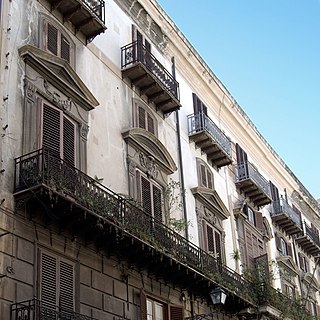
Palazzo Isnello is an historic palazzo situated between the ancient via del Cassaro and Piazza Borsa, in the Kalsa quarter of Palermo, Sicily.

Vito D'Anna was an Italian painter, considered the most prominent painter of Palermitan rococo and one of the most important artists of Sicily.

Angelo Italia was an Italian Jesuit and Baroque architect, who was born in Licata and died in Palermo. He designed a number of churches in Sicily, and later worked to reconstruct three cities following the 1693 Sicily earthquake.
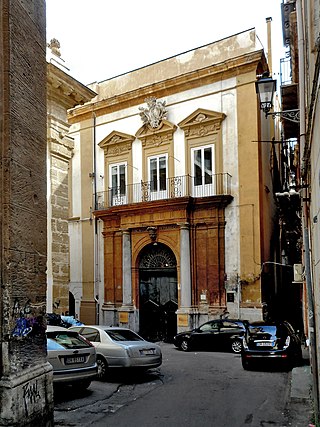
Palazzo Natoli is a Baroque palace in Palermo, in the Mediterranean island of Sicily. It was built by Vincenzo Natoli in 1765. It has a fine entrance on via S. Salvatore, and frescoes by Gioacchino Martorana.

Gioacchino Martorana was a Sicilian painter. He was the son of Pietro Martorana and a member of an extended family of decorators and artists from Palermo.
Pietro Martorana (1705–1759) was a Sicilian painter. He was the father of Gioacchino Martorana and a member of an extended family of decorators and artists from Palermo.
Lanza are a family of the Sicilian nobility descended from the Dukes of Bavaria.

Palazzo Comitini, complete name Palazzo Gravina di Comitini, is a Baroque palace located on Via Maqueda #100, adjacent to the church of San'Orsola in the quarter of Albergheria, in the historic center of Palermo, region of Sicily, Italy. Presently, it is the official seat of the Metropolitan City of Palermo and the columns flanking the portal read Palazzo della Provincia.

The Palazzo Alliata di Villafranca is former aristocratic mansion, now converted into a museum, located just off Via Vittorio Emanuele facing the Piazza Bologni which opens two blocks west of the Quattro Canti intersection, in the ancient quarter of the Albergaria of the city of Palermo, region of Sicily, Italy.

The Villa Cerami was once a semirural villa, located at the edge of the urban center and with a sizable surrounding garden, located at the Northern end of via Crocifero (#91), in the city of Catania, Sicily, southern Italy. Once a private home, it now houses the offices of the School of Jurisprudence (Law) of the University of Catania. It is located on a rise above the city, the villa was built atop the ruins of part of the Roman amphitheater of which some ruins are visible in nearby Piazza Stesicoro. Adjacent or nearby are three Sant'Agata churches: la Vetere, al Carcere, and alla Fornace. The route down via Crocifero passes four major Baroque churches and convents.

Villa Zito is an 18th-century palace located on Via della Liberta #52 in Palermo, region of Sicily, Italy. The structure is now owned by the Fondazione Sicilia and serves as their museum gallery and exhibition space for their collection of artworks, mainly graphic works and paintings, by mainly Sicilian artists from the 17th to the early 20th century.
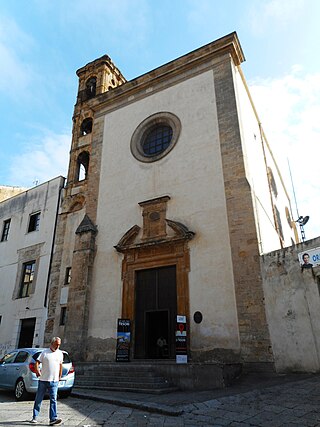
Santa Chiara all'Albergaria refers to a church and former monastery located in piazza Santa Chiara, in the quarter of Albergaria in the city of Palermo, region of Sicily, Italy. The church is located near the busy outdoor Ballarò marketplace.

Santa Maria di Valvedre is a baroque-style, Roman Catholic parish church located on Via Squarcialupo #2 in the quarter of Castellamare of the city of Palermo, region of Sicily, Italy.

The Palazzo Celestri di Santacroce, also known as the Palazzo Sant'Elia is a Baroque-style aristocratic palace located on via Maqueda 90 in the ancient quarter of Kalsa of central Palermo, region of Sicily, Italy. Once the urban palace of a wealthy and prominent family, a large portion of the palace is now used for exhibitions and private functions. The palace is diagonal to the Southeast of the Palazzo Comitini, and just a block north of the church of the Assunta.
Fabrizio Branciforte (1551–1624) was an aristocrat, 3rd prince of Butera and Count of Mazarin. He was knighted into the Order of the Golden Fleece in 1607.
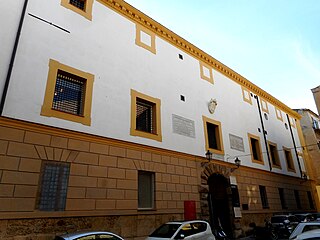
The Palazzo Branciforte is Renaissance-style aristocratic palace located on Via Bara dell'Olivella, in the historic center of Palermo, region of Sicily, Italy. It underwent extensive refurbishment under the direction of the architect Gae Aulenti, and since completion of the work in 2012 has been the home of the Fondazione Sicilia, and houses a modern library, auditorium, and exhibition halls.
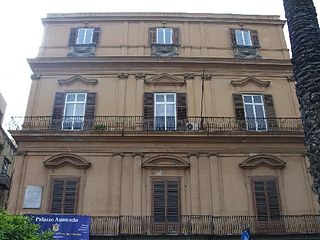
The Palazzo Asmundo is a late-Baroque aristocratic residence located on via Vittorio Emanuele, corner Via Pietro Novelli #3, in central Palermo, region of Sicily, Italy. The palace front faces the piazza and garden on the south flank of the Cathedral of Palermo. The privately owned palace is presently a museum and exhibition space.
The Palazzo Cesarò Colonna, sometimes called only Palazzo Cesarò, is a former aristocratic palace located on via Cassaro #417, now called Via Vittorio Emanuele, facing the church of SS Salvatore in the quarter of Seralcadi, in the historic center of Palermo, region of Sicily, Italy. The palace much altered from its origins, and the portal is dilapidated. It houses business establishments and apartments.

Madonna dei Rimedi is a Baroque-style, Roman Catholic Sanctuary-church, established and still affiliated with the Discalced Carmelite order, located on Piazza Indipendenza # 9, in Palermo, region of Sicily, Italy.


















